Monday, July 31, 2006
Bookworm Report: July
1. Everything You Need to Know About Lyme Disease..., by Karen Vanderhoof-Forschner. Good basic overview of Lyme, but I hope you never have to read it.
2. Strange Piece of Paradise, by Terri Jentz. I was psyched when I found this at our library, since I'd read several good reviews. A compelling story of a woman who was the victim of random violence; nearly two decades later, she traveled back to the scene of the unsolved crime to investigate it, identify a suspect and put her own emotional issues to rest. Could have used a more aggressive edit, but the story is quite gripping.
Thursday, July 27, 2006
Happy boithday, Bugs!
Tuesday, July 25, 2006
Coming attractions: fall '06 books
1. Just released is Helen Hamann's book Andean Inspired Knits: Designs in Luxurious Alpaca. It's interesting to me that this is the third book (the out-of-print Andean Folk Knitting that goes for mucho dinero on Ebay and last year's book by Marcia Lewandowski) that looks to Andean knitting for inspiration. I'm not sure if it's because there is lots of documentation and ample artifacts from which to draw; if it's the proximity of South America; or something about the fact that so many great yarns (like Manos) are drawn from South America. Whatever the reason, this book is devoted to patterns inspired "by pre-Columbian textiles from the culturally rich Andean region of South America."
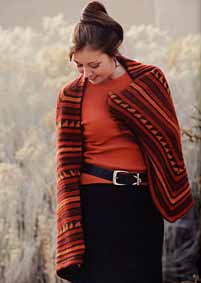
All of the garments are done in alpaca, which presents some design challenges: it's extremely warm and lacks the elasticity of wool. (This may explain the lack of tailoring and shaping that many of the designs seem to have.)
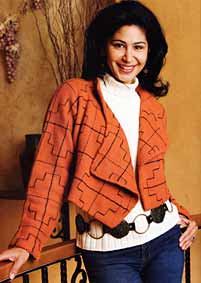
On the other hand, alpaca's luxuriously soft and has a great luster. Looks like geometrics, drape and warm color tones, from what I can tell. We'll have to see if the designs are contemporary enough for most people.
2. Also recently released is Louisa Harding's Natural Knits for Babies and Moms. I've already got a copy of this book, in part because several of the baby sweater patterns are done in DK weight, and I've got DK superwash merino being sold at Rosie's. (I have fantasies about doing a sample jacket for the shop...) These patterns are relatively simple and so could be done by a new mom or a relatively inexperienced knitter without too much trouble.

I love the fact that Louisa Harding has included some patterns for pregnant women and new moms, including some breast-feeding friendly designs.
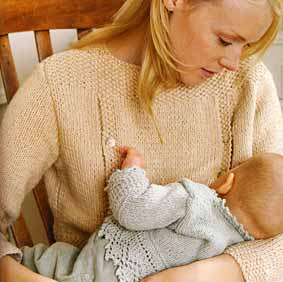
If you think it's not worth knitting for pregnancy, well, maybe you should shop for maternity clothes before you pass judgment. (Do I sound bitter?) And someone who plans to breastfeed for at least a year or two with multiple children may find the sweaters worth it. I also like the fact that the yarns used are all organically produced and naturally grown.
3. The ubiquitous Lily Chin releases Couture Crochet Workshop: Mastering Fit, Fashion and Finesse. Interweave describes this as embodying "Lily's philosophy [which] centers on constructing elegant wearables that fit perfectly" and states that the book will give you a review of "everything you need to master fit, fashion, and finesse." Only one or two designs were previewed in the materials I was given. Interestingly, no emphasis was placed on how fast one can crochet these designs. Nor could I determine if Lily's couture wedding glove pattern
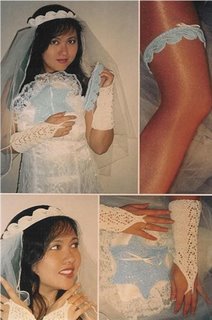
will be included.
4. One book I'm very much looking forward to is Spin to Knit, by Shannon Okey. Disclaimer: I met Shannon at TNNA and was quite taken with her. She's funny and sassy and irreverent, and we palled around for a little while on the show floor. Her book promises to provide the info you need to begin spinning, along with patterns to showcase your handspun yarns. And to make things even sweeter, she's going to come to Rosie's on her book tour this fall to sign books.
5. Okay, Loopy & Mar, for you, I will mention Time To Weave: Simply Elegant Projects to Make in Almost No Time, by Jane Patrick. Don't weave, don't even have a Weavette, so I'm not sure what any of this means, but the promos say that Time To Weave includes "an approachable and inspirational way to learn the fundamentals of weaving for the first time," including braiding, stringing, knotting, frame-loom weaving, straw-weaving and weaving over a pillow form. There appears to be an airy-fairy kind of approach that incorporates a quote and essay about the item or making it.
I will try to showcase some more new stuff that I've heard about to whet your appetite for fall, now that the dog-days of summer are upon us (or at least those of us in the northeastern U.S.). I'm also working on more sleeve tutorials, including responses to some reader questions.
Monday, July 24, 2006
Monday Props
The Philadelphia-area Boy Scout council occupies, rent-free, a nice piece of real estate in Center City that is owned by the City of Philadelphia. This arrangement has continued since the late 1920s. In recent years, however, the national Boy Scout organization has reaffirmed its discriminatory policy toward gays. The national Boy Scout organization forbids homosexuals from serving as troop leaders and scouts -- and even litigated the issue all the way to the Supreme Court. The Philadelphia council purported to adopt a nondisciminatory policy toward gays but then shortly thereafter, booted a Boy Scout who was openly gay. Last week, the city of Philadelphia put the Scouts on notice that they would have to either leave the premises or begin paying fair market rent in light of their discriminatory practices:
For several years, we have attempted to convince the Cradle of Liberty Council that its discriminatory policies are untenable and violate express City policy and law. Regrettably, we have been unable to obtain adequate assurances that the Boy Scouts will not, while headquartered on City property, discriminate.
It's hard to pin the Boy Scouts down on exactly why openly gay scouts or scout leaders bother them so much. They talk about gay scouts not making "good role models" for their "traditional values." They talk about a boy scout's pledge to keep himself "clean" -- and if you've ever been on a camping trip where it rains, you can imagine how silly this is. They mention not wanting men with DUI convictions or who are "promiscuous" as role models either. I suppose there are several factors at work here: part of it is the fundamentalist "Christian" (I purposely put the word in quotes) agenda that views homosexuality as a choice, a sinful "lifestyle," rather than a biological fact. I happen to think that sexual preference is something a person is born with, and can't change. Disciminating on the basis of a genetic roll of the dice, a biological imperative, is to me clearly wrong.
I also find the stereotypes and generalizations about gays that the Boy Scouts espouse to be troubling. The Boy Scouts apparently assume that gays don't have "family values"; but the gay parents I know put the lie to this stereotype every day with loving and conscientious care of their children. The Boy Scouts apparently assume that all gays are decadent, sin-loving libertines who want to teach impressionable scouts all kinds of naughty things; my friends who happen to be gay are kind, honest, caring and certainly no more decadent than any heteros I know (many a good deal less). And let's not kid ourselves: isn't underlying all this homophobia an element of "but we can't endanger our kids by leaving them with gay men," an assumption that being gay means you are a pedophile and could only be motivated by a desire to cop a quick feel in between S'Mores on the annual Jamboree? I hope I don't have to point out how utterly offensive that is. (By the way, I hope the Boy Scouts have also established a policy banning tarty, bleached-blond teachers from being scout leaders in light of the Mary Kay LeTourneau affair.)
If you think the Boy Scouts, as a private organization, should have the right to exclude anyone it wants from belonging, then ask yourself this: Would you feel the same way if the Boy Scouts excluded blacks? What if they excluded Roman Catholics? Would you want your tax dollars -- even if the form of foregone rent -- going to an organization that did so?
I don't.
Discrimination -- whether against blacks, Catholics or homosexuals -- is wrong. No decent religion requires it. And I believe our Constitution, frail and under attack as it is, forbids it. Well done, Mayor Street.
Saturday, July 22, 2006
Copyright Scofflaws
Somehow, a group of knitting and crochet designers got wind of this database, although it's hard for me to imagine how their paths crossed. Over the course of a week, various knitting and crochet designers joined this list. Suddenly, more posts about copyright appeared on this list than you can imagine. It was fascinating to see the different approaches of the various designers. Some adopted the "take no prisoners" mentality: "You are breaking the law and must stop immediately, you stealer." Others tried to sidle their way in: "Y'all seem like a nice group of gals, I'm sure we can clear up this innocent mistake." Joan Schrouder in particular proved herself to be a class act, taking many substantive questions from the copyright scofflaws and very pleasantly and amicably trying to express her point of view.
The response of the warshcloth ladies was equally fascinating. The moderator got defensive and began banning people left and right. She set up some kind of shadow list, with a name like "[Original Group Name] 2" and said she'd delist anybody who didn't email her with their real name and email addy by the end of this week.
And of course there were the ones opining in great detail about copyright law. For example:
If I don't want someone to use my patterns I don't put it out there to be seen. If these people are putting the patterns on web sites or blogs, do they not except [sic] someone to use that pattern. ... I know people who put on their
patterns that they are copyrighted a[nd] think that they are. wrong!!! Unless the
have paid the fees, did the paper work and gotten a government copryight number
and certificate of copyright, that pattern is not copyrighted. Anyone who has
done all this should be able to show you they hold a true copyright. Until then
they are lying and should close their mouths until they do have what they say
they have.
My faithful readers know that the United States Copyright Office disagrees:
When is my work protected? Your work is under copyright protection the moment it is created and fixed in a tangible form that it is perceptible either directly or with the aid of a machine or device.
Do I have to register with your office to be protected? No. In general, registration is voluntary. Copyright exists from the moment the work is created. You will have to register, however, if you wish to bring a lawsuit for infringement of a U.S. work. See Circular 1, Copyright Basics, section "Copyright Registration."
Some members delisted themselves in solidarity with the designers while the moderator banned all further discussion of copyright. She was backed by knitting sociologists like this one, who stated
I am so sick of girls, yes I mean girls. Not matter where you go in life this is always the problem. Girls never grow up. .... If I could find a job and a group full of men I would join and live happley ever after. Drop this now. ... Enough said, done, it is finished!!!
Shortly after the tempest began to rage, the files were taken down, then mysteriously appeared again in their original form. Designer members offered to help create links to any patterns that would take the readers directly there and to help purge the files but so far this hasn't been done.
In the meantime, it bears repeating that the person who creates an original pattern automatically owns its copyright; copyright ownership means the designer gets to decide where and how and on what terms to distribute her work. Even if it appears on the Internet, on a free or for-pay site, it still is the designer's prerogative to decide where else it can go. Stripping off the designer's name and copyright information is dishonest, not merely because of the legal ramifications but because it deprives the creator of the humble satisfaction of being recognized by all as the designer of that pattern. And in this crazy world of knitting, that is, sadly, sometimes all the designer takes home for her work.
Thursday, July 20, 2006
Update
The new doctor seems pretty sensible. He ordered a round of blood tests: first to screen out non-tick-related medical conditions with similar joint symptoms (a real parade of horribles including rheumatoid arthritis and lupus) -- but hastened to say he doubts any of them will come back positive; and second, to screen for other tick-borne illnesses that commonly accompany Lyme or can be confused with it. He prescribed another, stronger antibiotic to treat what he thinks is obviously Lyme that didn't get knocked out the first time. I also liked that he scheduled a follow-up visit for a month from now (unlike my original internist, who sent me off and clearly didn't want to see me again. Ever.) and recommended acidophilus to compensate for the kill-off of bacteria. So we shall see.
In the meantime, just to torture me even further, it appears that lovely little Grace will need eye surgery within the next month or two. She has a strabismus, which is one of those eyes that lollygags off to the side and she does not have true binocular vision. We have been tracking it for a while, and her regular doctor recommended surgery since the problem has not resolved itself and is, in fact, getting worse. Tom took her for a second opinion today and the doctor unequivocally agreed. I hope they do mother-daughter anesthesia.
And while I'm the voice of doom and gloom, let's pay tribute to one of our own, Barbara Albright, who died earlier this month at the ridiculously young age of 51. Ms. Albright wrote several knitting books (including the recent Oddball Knitting, for using up leftover scraps of yarn) and had an interesting-looking book called The Natural Knitter: How to Choose, Use and Knit Natural Fibers from Alpaca to Yak that is forthcoming. Ms. Albright also wrote books about food, in particular chocolate; anyone who writes a book called 1001 Reasons to Love Chocolate must have been my kind of gal. She was diagnosed with a brain tumor this spring. Yes, sobering, isn't it?
If you haven't already checked out the RosieBlogs series of posts on knitting with handdyed yarns, you really should. Lisa Myers has outdone herself with some really great, substantive discussions of how to use hand-dyed yarns, with lots of photos to illustrate her points.
Finally, here is a new website that bears watching: Stupid Knitted Crap. Whether you enjoy or scoff at the oddball entries, this looks to be a collection-in-progress of the strangest knitted stuff out there.
Monday, July 17, 2006
Naivete crashes against the rocks of reality
Not so fast.
What I have now learned is that Lyme is an incredibly frustrating and confusing disease to get. Not the least of which because there is so much disagreement about it and so much that is simply not known for sure.
Everyone agrees that ticks carry a variety of disease that can be transmitted to humans, of which Lyme is merely one (and the most well-known). Everyone agrees that an organism called a spirochete is responsible, and that a tick bite can transfer spirochetes to a human. The spirochetes multiply in the human body and cause various symptoms, including fatigue, aches, chills, joint pain and fever. Everyone agrees that certain antibiotics are generally effective in treating at least some cases of Lyme, and that if left untreated, the spirochete will infest the nervous system and may cause a parade of horribles including facial paralysis, arthritis, multiple sclerosis and more.
But here's where the body of conclusive knowledge ends and the frustration begins.
It is very difficult to diagnose Lyme. Lab tests are notoriously unreliable and frequently give false negatives. Why? Not sure. Could be some people are tested too early, before antibodies are made; people who take antibiotics like me may not make enough antibodies to show up; labs may not be sensitive or careful enough; or maybe we just don't know enough to know why there is such a high rate of false negatives. If you get the famous bull's-eye rash (think the Target logo), oval or circular, sometimes with a white center, that is considered a conclusive diagnosis of Lyme. But if you don't get the characteristic rash (and some people don't; estimates range from as high as 70% to as low as 20% of Lyme patients do NOT get the rash) or if you don't see it (if it's on a part of your body you can't see well, like your back, or that is covered with hair, like your
It is also difficult to treat Lyme. There is widespread debate about what it takes to knock out the spirochete. The most conservative say 7 to 10 days of antibiotics; others say 4 to 6 weeks; some say a minimum of 6 weeks of treatment is required because the life span of the spirochete extends for at least a month so you have to treat long enough to be sure you've killed all stages of it. Some say oral antibiotics are enough; others say intravenous are necessary, at least in some cases. Some say 100 mg of Doxycycline twice a day is enough; others say at least 300 to 600 mg per day is the minimum required; some say other drugs are better. Some doctors scoff at Lyme patients, saying it's all in their head and referring them to shrinks if their symptoms last longer than the doctor thinks is reasonable.
As a newly-diagnosed patient, I took my meds but now am seeing additional symptoms crop up. The most troubling of these is joint stiffness, swelling and pain. It may horrify you to know that IT'S AFFECTING MY KNITTING. (It horrifies me, too.) I've never had any of these symptoms before (e.g. a strange creepy-crawly sensation on my skin, like brushing against a spiderweb but there's nothing there; to the point where I've scratched the skin raw in places) and they are well-documented in the Lyme literature so I have to think there's a connection.
My regular internists pretty much have dropped the ball. When I phoned to report additional symptoms, their reaction was to ask for a blood test to make sure I really have Lyme's. Not helpful. (See, for example, the Center for Disease Control website: "Validated laboratory tests can be very helpful but are not generally recommended when a patient has [the classic bull's eye rash]." or WebMD: "If you have symptoms of Lyme disease but test results are negative, treatment should not be delayed. " and "Detecting antibodies to the bacteria that cause Lyme disease does not always mean that the infection is active.") If the test is accurate, it will certainly show antibodies since I had the disease (hence the rash), but it won't tell whether the infection is active and on-going or merely leftover antibodies. If it's not accurate, it'll suggest I don't have Lyme, which I suppose will mean it's all in my head.
So I decided to consult an expert, someone who really knows Lyme, who can tell me if I've been "cured" and these are just residual symptoms, or if I need more treatment. There aren't that many specialists in Lyme, and ones that are considered Lyme-friendly, meaning they won't send you to the men in the clean white coats if you complain of long-term symptoms, are highly sought-after. The first doc I called had a one-year waiting period for new appointments, took no insurance, and charges $750 for the first visit plus over $2000 in required lab tests (only 25% of which might be covered by your insurance, if you're lucky).
I ended up with an appointment with a doc in New Jersey. Here's hoping he understands why a disease that interferes with my knitting MUST BE ERADICATED.
And the sooner the better.
Friday, July 14, 2006
Having a fit: Sleeves, part I
For far too many years, I did not know the difference between the various kinds of sleeves, to my sorrow. Because different kinds of sleeves will look very, very different on a human body. I had this vague dissatisfaction about some of my sweaters and shirts; I knew they didn't fit the way I wanted them to but I didn't know why. On the other hand, I had sweaters and shirts that I loved and wanted to wear all the time. Intuitively, I knew they fit me better and were more flattering, but again, I just couldn't put my finger on why.
After I began knitting, and reading extensively about knitting, I discovered that one very significant factor in whether I would love a sweater or not want to wear it much was the structure of the sleeves. So here is part I of the Official Go Knit In Your Hat Sleeve Tutorial. (More parts will come as I write them. Be patient; I scanned and loaded a buttload of photos for your edification.)
Let's start with drop sleeves. Here's a schematic of a sweater (I know you can read schematics, because we talked about them eons ago, right?):

This is the most basic sweater one could possibly design or make: it's a bunch of rectangles. Rectangle for the front, rectangle for the back, even the sleeves are rectangles. It's easy to make because you don't have to do any increasing or decreasing; you just knit rectangles. It's easy to design because you don't have to plan any increasing or decreasing, and if you are going to use some kind of pattern stitch, or stranded design, or cables (and I hope to God you are, or it's gonna be one boring damn sweater), you don't have to worry about increases or decreases or pesky sleeve openings cutting into the pattern. Note that I've marked the place where the sleeves are sewn to the body with blue lines and labeled them "seam lines."
This is a slight variation on the Rectangle sweater: it's the Modified Rectangle model. Still uses rectangles for front and back, but the sleeves are now trapezoids (they start narrower and increase as they go up).
What is most important about either of these sweaters for our purposes is the place where the sleeves meet the front and back. In both versions, there is no shaping, no cutting in for where the sleeve meets the front and back. You can see the sleeve top is a straight line and it's sewn in a straight line to the straight edge of the front and back.
And that's the problem.
Women's shoulders look like this.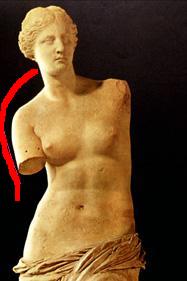
They slope downward and are curved. Their arms continue this sloping line.
When you put a drop shoulder on a woman, you are trying to superimpose a boxy rectangle on a sloping, curvy form.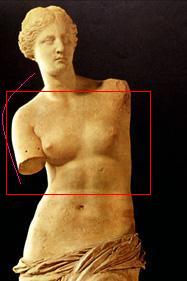
It doesn't match. And that is why you end up with all kinds of extra fabric pooching out in all the wrong places.
Let me give you some examples.
This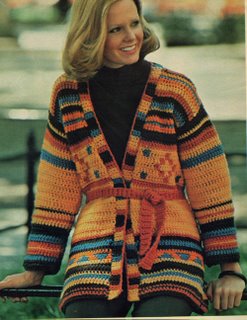
is an abomination from my collection of vintage patterns (meaning all the old magazines and crap stuffed in the office upstairs). Now I've marked it up a little:
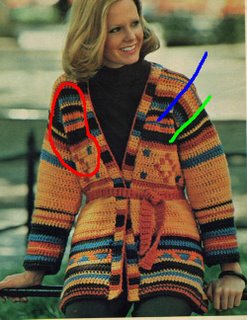
The green line shows where the seam line is, i.e., where the sleeves are sewn to the body of the jacket. The blue line shows about where the model's natural shoulders are. See where that seam line falls? See how it drops off the model's natural shoulder line? That's the Dreaded Drop Shoulder. From a fashion standpoint -- and more important for us, a fit standpoint, the Drop Shoulder is the Seventh Sign of the Apocalypse. It is Evil. It is Unattractive. Very few women look good in a drop shoulder sweater.
You can see why pretty easily: the sweater doesn't follow the natural curve of the woman's shoulder. It sags and there's unnecessary knitted fabric that hits in all the wrong places (some of which is shown in the red circle). Yet for as unattractively as they fit most women (and I'm sure there are exceptions to this rule, which smug commenters will promptly tell me about) drop shoulder sweaters are ubiquitous. You can't open a Dale of Norway pattern book without getting hit over the head with them: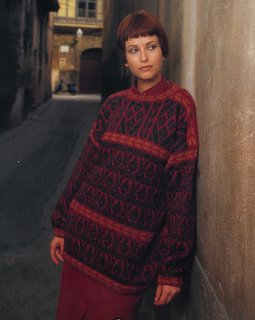
Lovely patterning, no? But it looks sack-like on the (almost certainly very slender) model: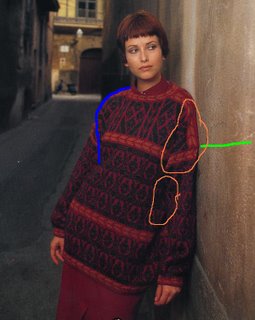
There's the seam line, shown in green. The natural line of the model's body is shown in blue, and the circles show some of the extra fabric that contributes to the burlap sack look. Don't get me wrong: I love Dale of Norway. But for as exquisite as the stranded knitting and colorwork and ethnic designs of traditional Dale sweaters are, many of them, oh so many of them, have those poky, saggy drop shoulders.*
Here's one from Rowan:

Marked-up:

The alternative to drop shoulders are set-in sleeves. Set-in sleeves are a little harder to make, and harder to design, but they are infinitely more flattering to wear. If you were dissatisfied with your last sweater project because of the way it fit, and it had drop shoulders, don't give up on making sweaters yet. Try a sweater with set-in sleeves.
Set-in sleeves are sleeves which are "set in" to the body of the sweater. When you are knitting the front and back, to get to the place where you want the armhole to start, and you bind off stitches in each side, like so:

You may bind off a few stitches or a lot, and you will probably continue to do some decreases as you continue the body of the sweater to get rid of that extra fabric that you don't need there. When you knit the sleeves, you will make a similar line of bound-off stitches and possibly decreases, in order to create an edge that mirrors the lines of the front and back. You want the edge of the sleeve to mirror the armhole of the front and back so that you can match those mirror edges and sew a seam.
Now look at some set-in sleeves from Rowan.
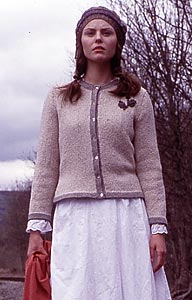
The marked-up version:
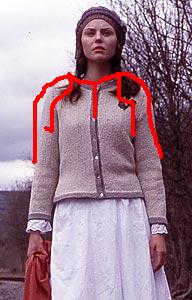
See how the sweater follows the natural line of the model's shoulders, shown in the top red line. See how the structure of the sweater, marked in the second red line, cuts in for the sleeves, eliminating the extra fabric. And see how much neater, less sloppy, more trim and well-fitting it looks?
Here's a denim jacket:
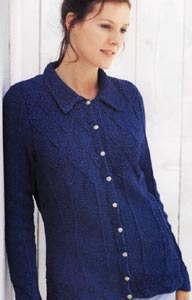
See the difference? Here's why:
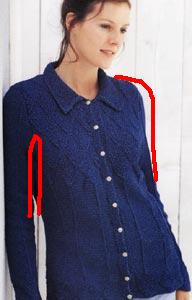
Again, the jacket follows the natural line of the model's shoulders (line on the right) and instead of having extra saggy, baggy fabric, it fits beautifully (look at the red line on the left, where you can see how the sweater nips in for the armhole and sleeve). What a difference.
If you learn nothing else from my blog but the difference between drop shoulders and set-in sleeves, I will be able to sleep well tonight.
*To be fair, in recent years, Dale has made an attempt to show more women's sweaters that have other kinds of sleeves.
Thursday, July 13, 2006
This and that
I mentioned that RosieBlogs, the official blog of Rosie's Yarn Cellar, would feature some articles on how to use hand-dyed yarns this week. Yesterday's entry (written by yours truly) gives a brief overview of the process of making hand-dyed yarns. Don't miss the posts by Lisa Myers covering the use of color, repeats, pooling (and other undesirable color effects and how to avoid them). One of these posts should appear sometime today.
In the meantime, Black Bunny Fibers is starting to look more like a storefront as I've had a chance to add some wool-nylon sock yarns & some more roving (there's one Finn left and I've got some Falkland coming soon). Two large hanks (1750 yds) of laceweight are coming soon, one bright fuschia and one lavender-blues.
Fellow sockheads might want to check out the new blog The Traveling Sock, which features photos of handknit socks in farflung and unusual places. It's fun seeing how different sock yarns knit up; my kids would love the Regia Nation in the big block stripes. (Thanks to Amputeehee for the link -- I wish your socks weren't so blurry!)
Monday, July 10, 2006
Taking a bite of the big apple
I started out on the train, disembarking at Penn Station. Whilst visiting the ladies' room, I caught sight of a striking cardigan crocheted out of multiple colors of teeny-tiny skinny yarn. Surely it was... Kathy!
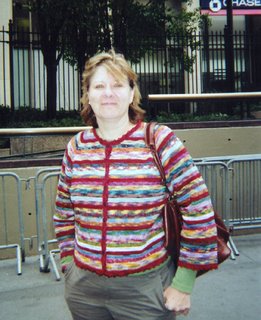
[Please forgive the poor photographic skills. Alas, I am no Franklin.]
We joined forces and proceeded to Habu. Outside, we found Marilyn and her granddaughter Liz. Liz is way cool and someday will be a tattoo artist. She was extremely good-natured in putting up with us and an overall good sport. This is Liz, looking fetching in a hat at the 9th Avenue street fair:

Next we discovered Lisa and her mother.

What's that, you say? You can't tell which one is Lisa and which one is her mother? It's true: Lisa's mother is extremely, almost infuriatingly young-looking. Little-known fact: she's also a former model. [If you click on the link, scroll down. She's not that young-looking.]
On to Habu, my first time there. Of course, I'm no mere slip of a thing, so I felt like a huge mamoo in there and every time I turned around, I nearly knocked over some precarious display of yarn or handwoven screen, but I triumphed over my American-ness. You could spend all day in Habu, just looking through the skeins of yarn artfully arranged in hanks, feeling them, exploring the unique fibers (pineapple ramie? stainless steel/wool blend?), mixing and matching colors.
We then moved on to Schoolhouse Products, which was an experience of a totally different nature. Lots of commercial yarns, but also some odd lots and coned yarns. Why, here's an odd lot:

I like Lars better nekkid surrounded by yarn in his tub (you'll have to go to his blog for that), but he's awfully attractive here, too.
Lunch was at a delicious Thai place. I got to meet world-famous author and hottie Norah Vincent. Which will prove more conclusively that I met her, the photo of my big old moon face next to her?
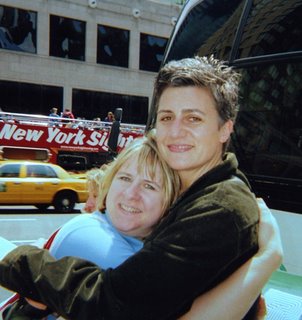
or the photo of her holding her book while giving me the finger?

You decide. (Is it me, or does Norah have the longest middle finger in the world? Probably the result of overuse.) Then we were off to the Japanese bookstore, where we encountered a rather disturbing collection of images in various art books -- and I got a Hello Kitty alphabet book for Grace ("Y is for yoga instructor") and a cool men's knitting book for myself. A final stop for coffee and gossip, and the partial meeting of the Wolverinas was adjourned.
Coming soon: More on fit, ribbing, and whatever else comes to me.
Friday, July 07, 2006
Bookworm's Yada-yada: May & June
1. Snowbound, by Christina Bartolomeo. Chick-lit, with the typical plot line: dump unappreciative old guy, get makeover, snag new guy who's way better than the old guy. Better written than most in the genre, and she went to my husband's alma mater, Dickinson College, but I doubt this one'll be nominated for the Booker Prize.
2-4. First three Kate Martinelli mysteries, Laurie King. Good mystery series set in L.A. The first and third were especially good; the second one not quite up to their calibre.
5. The Cutter Incident, by Paul Offit. Here's another hometown connection: the author's wife is one my kids' pediatricians. The first half of the book is a fascinating description of the American polio epidemic and the search for a vaccine. My parents' generation talks of how frightening the polio scares were -- how swimming pools were closed, the paranoia that took over and the images of tiny children strapped into iron lungs when they couldn't breathe for themselves. The desperate desire to find a vaccine backfired when certain faulty doses injected children with live, active polio virus, causing children and adults to contract the disease as a direct result of the vaccinations. Underscores the need to continue developing safe vaccines, but left me a little unsatisfied as to exactly what our society ought to do to achieve that without jeopardizing safety. The end crosses over into an anti-lawsuit polemic that tries to sneak medical malpractice (as opposed to holding the manufacturer of a product, such as a vaccine, liable for damage caused by that product) reform into the debate; this is, in my opinion, a completely separate issue.
6. Our Town, by Cynthia Carr. Nonfiction account of a writer's quest to find out what really happened in 1930, the night two black residents of her hometown were lynched. She juxtaposes the background of the lynching and an account of the KKK in Indiana with her own personal quest to find out about her grandfather's life, including more about his membership in the KKK. Gets a bit long-winded at times.
7. The Lost Night, by Rachel Howard. This was a very quick & engrossing read, the memoir of a San Francisco writer who sought to learn more about the murder of her father. Howard was ten when her dad was stabbed to death, and didn't begin talking about her father's death until she began writing as an adult. It's not so much a whodunit as it is a daughter's attempt to come to grips with the effect this tragic event had on her life and personality. Excellent.
8. The Minotaur, by Barbara Vine. Typically well-written and creepy mystery set in England.
Wednesday, July 05, 2006
Christina deserves an answer
why do designers stop sizing at 40 inch busts, especially since 67% of American women have more than 40" of rack? Secondly, why the HELL did Cheryl Oberle "size" her patterns in "Folk Vests" with bigger needles?
Christina is not alone. Time and time again, I hear people complain about the limited size ranges that commercial patterns come in. More commonly, knitters complain about the sizes not going big enough but I also have a colleague at Rosie's who has trouble because the patterns don't go down small enough for her extremely petite figure.
I wish to take a stand, first of all, on the issue of "sizing" patterns by suggesting that the knitter use a larger needle. It's crap. It's lazy. It's sloppy.
When I work with a yarn, I play around with different needle sizes until I find one that I think creates the best fabric for my project using the yarn. Using a larger or smaller needle than that won't give the same quality of fabric. There can also be other issues of proportion and gauge that make this unworkable. To suggest that a sentence saying "For a larger size, use a larger needle" is tantamount to resizing the pattern is bullshit. I'm right there with you on that one, Christina.
Now onto the meatier question of why commercial patterns don't come in a larger range of sizes. If statistics showed that, say, 60% of all American men wore a size 9 or larger shoe, do you think that shoe manufacturers would make, say, 80% of all men's shoes in size 8 or smaller?
Me neither.
Leaving aside the potential question of sexism, why do pattern manufacturers seem to consistently overlook larger sizes?
My own personal suspicions are crass. First and most significant, I suspect that pattern manufacturers simply don't pay their designers enough for designers to want to write their patterns in a wider range of sizes. It is work to create a broad range of sizes in a pattern; it's not just a matter of math, but also proportion, and fit, and other things. If you're getting paid a nominal amount for a design, or in some cases, nothing, you just don't have much of an incentive to go out of your way to increase the size range of your patterns. Why do more work for the same money?
This is not a slam on designers (although in some cases, laziness may be part of the problem). Designers just don't get paid that much for the amount of work that goes into creating a design. A lot of people design for the love of the craft, and this means that there are lots of people willing to produce designs for free or very nominal amounts. It's hard to lobby for more money when someone else out there is willing to do it for free. Remember, when you design a sweater, you have to knit up a sample garment (sometimes providing the yarn yourself) as well as writing the pattern. For e-zines like Knitty, you also have to provide photographs. You might be getting paid as little as a hundred or a hundred and fifty dollars for an adult sweater, maybe with cables or fair isle or some other labor-intensive design feature; try hiring a test knitter while keeping a significant proportion (any!) of that amount! You may not have that much time to turn around a sweater, and you may face additional challenges adapting your original concept to the finished garment. (What if you swatch a design in a fingering-weight matte wool in a solid color, and the company purchasing the design sends you a bag of worsted-weight variegated mohair with sparkles?)
Another cynical idea that crossed my mind was that maybe pattern manufacturers don't particularly care if larger-sized people make their designs. Let's face it: many of the designs out there are made for models who look like sticks, who are very tall, with no boobs or butt and with an extremely low body fat percentage. That sweater isn't going to translate well on a curvy woman with different body proportions. The pattern manufacturer may figure that women above a certain size just aren't going to make that cropped tube top, so why bother sizing it way up?
Being the gonzo blogger that I am, I decided to go a step further and ask a bunch of knitting designers. I posted a query to a knitting design list I belong to and got these additional reasons:
1. Fit of garments can't always be changed simply by making the size bigger; bigger bodies have curves in places that smaller bodies don't and require more individualized tweaking to look good. Sometimes this would require completely reworking a design and altering it. A knitter will probably get a better result for her individual body by tailoring it to her particular body.
2. It takes more time to knit sample garments in larger sizes than in smaller ones. Deadlines are often extremely tight, giving a designer only a few weeks from swatch to finished garment.
3. The overall style and age group of a design may determine the size range. "Hipper" and "trendier" designs may be geared to smaller sizes on the theory that younger women and teens tend to be slimmer, while more "classic" designs may appear in a larger range of sizes.
4. When publishers try to market designs at the large end of the spectrum, people don't buy them and so they've stopped doing them.
5. Publishers like simple patterns that are easy to edit and follow. The wider the range of sizes, the more complicated (and lengthy) the pattern gets. (For example: For sizes XS and S, do X. For size M and L, do Y. For sizes XL and XXL, do Z.) Many knitters like simple patterns, too, and it costs less to produce shorter patterns (less pattern, less paper) so there are many incentives to keeping patterns short and as uncomplicated as possible.
So there you have it, Christina. Some of those answers make sense to me: for example, the idea that you'll get a better fit by individualizing the pattern to your body needs makes sense and is true, to a more or less degree, for many knitters who don't fit into an "average" set of measurements. Others, like the publishers aren't interested in plus-size knitters, don't sound very valid to me.
Before I turn over the comments to you readers, it bears asking whether it is, in fact, true, that patterns don't come in a wide range of sizes. Let's set aside
Big Girl Knits and Classic Knits for Real Woman by Martin Storey et al., the two recent entries into the world of "plus-sized" knitting. And don't get me started on the Delta Burke collection of patterns.
Rowan patterns have in recent years tended to stop at a 40-inch or maybe a 42-inch bust for women -- pretty small. (However, Rowan announced at TNNA that, beginning this fall, their patterns would include expanded size ranges. We'll see whether this includes all of their patterns and exactly how expanded they will be.)
Dale patterns traditionally go way up in size; the problem is that they tend to be extremely time-consuming stranded patterns with drop shoulders and no shaping. Not very conducive to playing up one's body strengths.
A recent Elsebeth Lavold book shows patterns with finished (I think) bust sizes of up to 54 inches in one particular pattern and 51 inches in another. Pretty good.
A 2004 Knitter's Magazine showed some patterns in expanded size ranges (including a nice Elsebeth Lavold one that went up to the 50s) but others ended at 40-inch busts.
A recent Interweave Knits also showed some patterns -- but certainly not all -- with a finished width in the high forties or fifty-odd inches.
This very unscientific survey suggests to me that the breadth of sizes offered in today's knitting patterns is, well, uneven. Tank tops and other skimpier or close-fitting garments tend to have more limited size ranges than cardigans and more traditionally-styled sweaters (perhaps illustrating points 1 and/or 3 above).
Okay, readers, I'm sure you're foaming at the mouth on this juicy topic. Have at it. And I hope all my American friends had a wonderful Independence Day and that my loyal Canadian friends had a terrific Canada Day.

